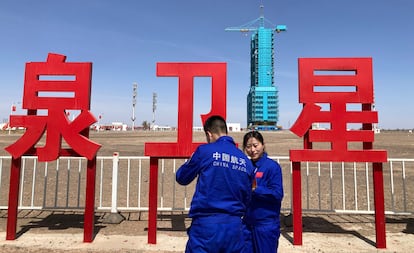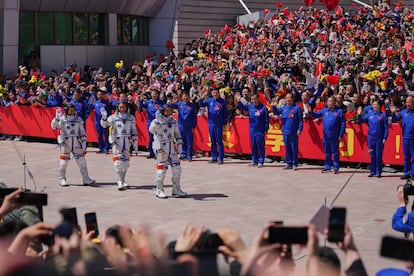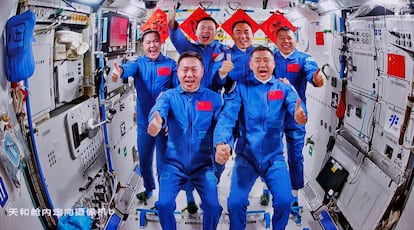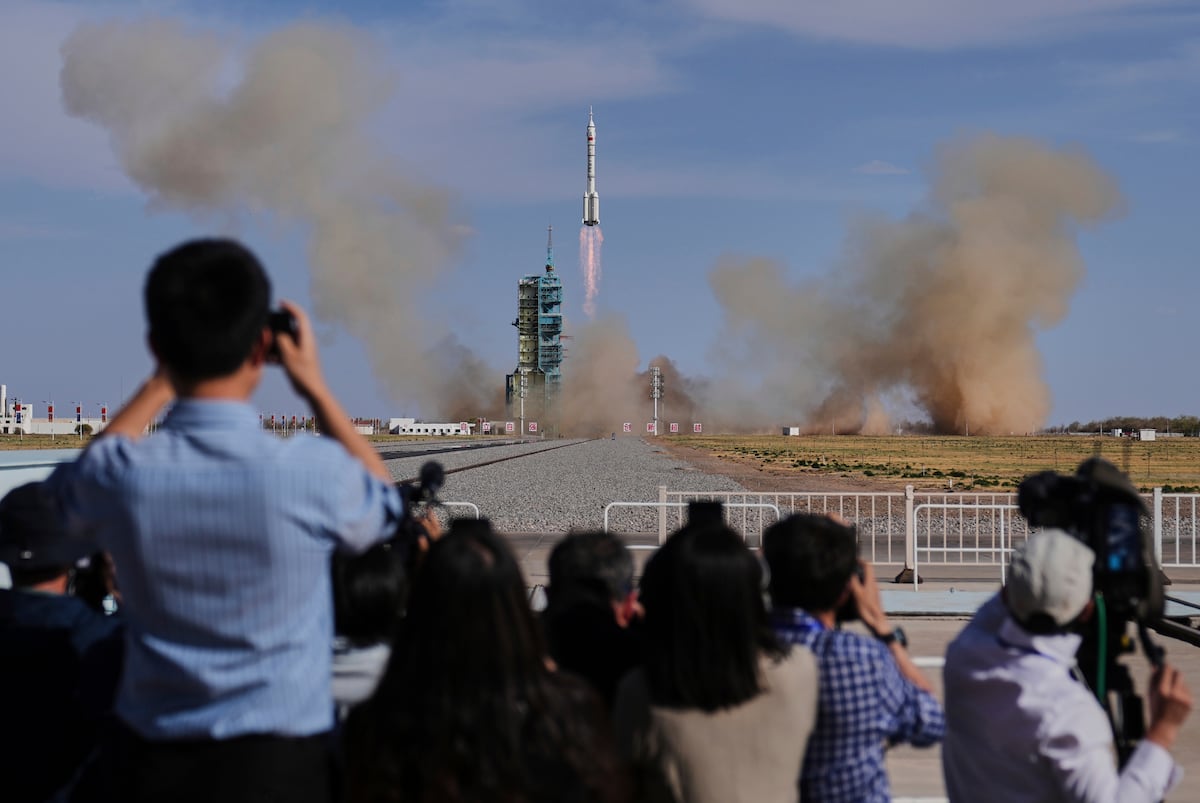Two hours and fifty-one minutes before liftoff, the three Chinese astronauts parade before hundreds of people. Dressed in space suits, they square off with a military salute. The crowd waves red pennants with five stars and intones a well-known patriotic anthem accompanied by an orchestra: “We sing to our beloved motherland, which, right now, is advancing towards prosperity and strength!”
One poster encourages the public to “learn from the astronauts.” Another reads, “The homeland and the people are waiting for your successful return.” And another, “Our voyage is heading for the starry skies and the vast ocean.” The three white figures get into a van and wave one last time. They drive off. The Long March 2F-type rocket, which will propel the manned Shenzhou-20 spacecraft, awaits them on the launch pad at the historic Jiuquan launch base in the middle of the Gobi Desert in western China. “I’m happy!” says a boy who has come all the way from Shanghai, over 1,200 miles away. He wears the red scarf of the Young Pioneers around his neck; his mother, a sticker with the Chinese flag on her cheek.
It is Thursday, April 24. China is about to execute the 35th flight of its manned space program. The three taikonauts — a word that comes from taikong, which means cosmos in Chinese — are scheduled to take off for the Tiangong space station, one of the jewels of the People’s Republic’s space program, and one of the best examples of the Asian giant’s rapid progress in the space race, which has been noted with some consternation by the U.S. as Donald Trump’s administration is threatening to cut NASA’s science budget by half.
Liftoff offers a rare opportunity to spend a couple of days inside a base controlled by the military and sealed off from the world. The Jiuquan Satellite Launch Center is an almost sacred place in Chinese cosmic mythology: inaugurated in 1958 as a testing ground for intercontinental missiles, several of China’s great space missions have launched from here.
On the day of the Shenzhou-20 launch, people start to gather at the entrance to get the best view possible, just like at Cape Canaveral. Numerous buses are seen on the roads in the area; there are those who have pitched a tent on the desert soil; a father has brought his son; a group of retirees wait in the shade offered by a souvenir stand. Next to it, a huge sign indicates that one is about to enter forbidden territory: “Leaking secrets leads to imprisonment; protecting secrets brings happiness; selling secrets leads to execution.” Attached is a telephone number to report acts of espionage.
Once through the gate, the center does not appear to be a paragon of cutting-edge technology, at least as far as the authorities are prepared to show the foreign press. The tour does not include access to control rooms full of monitors or futuristic laboratories. The buildings visited are simple, and their interiors modest. As you move from one side to the other, you can make out spatial motifs here and there. One of the traffic roundabouts has been decorated with rockets and satellites; sculptures of chubby astronauts have been placed in a park. The lampposts reproduce what looks like the wake of a spacecraft. Officials in blue overalls with the Shenzhou-20 mission patch on their shoulders are everywhere you look.

Ma Siran, a 25-year-old from Beijing with tousled hair, is the author of the patch design. He has been invited to watch the launch and explains why he came up with a triangular emblem: “It represents cutting-edge technology, stability, reliability. It has a futuristic touch. I want the next generations not to lose the spirit of innovation and keep trying something different,” he says.
Everything is set up to highlight China’s growing role in space. At the base, a huge billboard with the image of President Xi Jinping, dressed in military attire, encourages the public to “explore the vast universe” and build a “powerful space country.”
Washington observes the speed with which Chinese milestones are being reached with concern. Space has become yet another battleground for the two rivals, who are also engaged in a colossal trade battle following Trump’s extraordinary tariffs and Beijing’s commensurate response. There are echoes of the Cold War. At stake is the ability to innovate, to put cutting-edge technology to work, and military dominance. Sending a rocket into space shows the power of a nation and is at the same time a way of projecting its soft power in the form of dreams for future generations.
In early April, U.S. Space Force chief General Chance Saltzman warned Congress that China’s rapidly advancing program represents a significant challenge to U.S. dominance in orbit. He called Beijing’s ambitions a “powerful destabilizing force.” The pugnacious tone was adopted by Jared Isaacman, the billionaire whom Trump has nominated to head NASA: he promised that the U.S. will return to the Moon before China and insisted that his priority will be to reach Mars with a crew.

The next five years will be decisive. The People’s Republic of China has set itself the goal of sending astronauts to the Moon before 2030 and, in the medium term, to establish a permanent base on the satellite, a project it is preparing in collaboration with Russia. It has already succeeded in landing a robot on the far side of the Moon, bringing back samples; it has sent a probe to Mars, a planet which is also the target of manned missions, although at a much more distant date.
“Preparations for the manned lunar mission are progressing satisfactorily,” Lin Xiqiang, spokesman for the China Manned Space Agency, said on April 23 at an appearance at the base. Lin explained that the Long March-10 rocket and the manned Mengzhou spacecraft, the Lanyue lunar lander and the Wangyu lunar rover are “developing prototypes as planned.” Soon, he added, some equipment will enter the testing and validation phase. This week, the head of China’s Chang’e 8 mission — scheduled for 2028 to lay the foundations for the construction of the lunar base — revealed some details of the plan, such as the possibility of building a nuclear plant on the satellite to supply the future station’s energy needs, according to Reuters.
Decades after the last manned Moon landing in 1972 by the U.S. Apollo 17 mission, the Moon has become a place to return to. Zhang Wei, a researcher at the Space Applications Center of the Chinese Academy of Sciences, believes it has to do with a new approach: until now, lunar exploration was primarily aimed at studying the Moon. This “more scientific” approach has given way to a stage of “lunar exploitation,” he said during a press conference. And the new phase requires the ability “to explore and excavate.”
Zhang mentioned resources that could be exploited, such as the Moon’s solar energy, lunar ice and some minerals, such as ilmenite or helium-3, an element that some describe as the fuel of the future. “Our technology is in the process of continuous development, and we can explore, develop and use the Moon more widely, which will help humans advance further,” he said. Asked if he thought China would win the race back to the Moon, he said they would follow their road map in a steady fashion: “We are not going to compare ourselves with anyone,” he said.
Zhou Yaqiang, a senior technology official in China’s manned space mission program, also dodged the question about rivalry with Washington: “Our country’s entire space industry upholds the general principle of peaceful use and development in the service of mankind,” he replied. Zhou dwelt instead on details of the Shenzhou-20, the mission that is about to launch. One of its goals, he said, is to “lay a better technical foundation for the manned lunar landing mission.”

The Tiangong space station is a testing ground where China conducts scientific experiments in its bid to make progress exploring the cosmos. Its first module was put into orbit in 2021; it entered the operational phase in 2022; since then, it rotates its crew every six months — those on the Shenzhou-20 take over from the three on the Shenzhou-19. In the future, it could become the only one of its kind, when the International Space Station — a U.S.-led project, in which China is vetoed because of the military ties of its space program — is retired in 2030.
During their stay on the Tiangong — which translates as a Heavenly Palace — the Shenzhou-20 crew plans to conduct 59 scientific and technological experiments on biological space science, microgravity physics and new space technologies, according to the spokesman, Lin Xiqiang. They will seek to make progress in areas such as chip culture for vascularized brain organoids — cells that resemble the human brain — non-equilibrium dynamics of soft matter, and space preparation of high-temperature superconducting materials.
To date, the station has hosted more than 200 scientific projects, and more than 100 generated samples have been returned to Earth for study. And its laboratories have taken steps toward the in-orbit production of Bose-Einstein condensate, matter obtained at temperatures near absolute zero, as well as the construction of the world’s first experimental platform for quantum simulation with space optical networks, according to the Chinese Manned Space Agency.
Some of the experiments are expected to provide relevant results in the development of new materials, the study of the physiological effects of space radiation and bio-magnetic effects at the molecular level. The new mission will investigate planarians, a type of simple-structured flat worm, Streptomyces bacteria and zebrafish to study problems such as bone loss and cardiovascular disorders caused by weightlessness, medical problems that pose a challenge to human exploration of outer space.
“Every space trip is unique,” said Commander Chen Dong, who heads the Shenzhou-20 mission, a day before liftoff. He is one of China’s most experienced astronauts. A 46-year-old highly decorated combat pilot, he was about to blast off for the third time into space. “We hope to gain more experience and witness breakthroughs in the operation. The most important thing is to complete the work with zero mistakes,” he said from behind a glass case in which he and his crew were presented to the world to avoid contact.
The commander pointed out that liftoff would take place exactly 55 years after China’s first major space milestone when, on April 24, 1970, the People’s Republic launched a satellite into orbit for the first time. That episode flagged up the ambitions of a nation that was trying to emerge from poverty and leave behind what is often referred to as the “century of humiliation.” Times were hard, with the country in the throes of the bloody Cultural Revolution. Chinese writer Liu Cixin, one of its most renowned science fiction authors, has spoken about the impact of that milestone on him as a child, and how it made him project his dreams into space. He is now widely read outside China while being respected by the authorities in Beijing, who are aware that science fiction helps to build the country’s narrative as a technological power.
“It was the prelude to the exploration of the vast universe by the Chinese people,” said Commander Chen, flanked by the mission’s crew, maintaining a note of patriotism throughout. “This is not only a story about China’s struggle in space, but also a glorious story of liftoff.”
“I am lucky to have been born in the new era and to be able to unite my personal dream with the Chinese dream and the space dream,” added crew member Chen Zhongrui, 40, also an ex-air force pilot. The youngest of the three, Wang Jie, a 35-year-old aerospace engineer, recalled a childhood episode in his home province of Inner Mongolia: it was there that Yang Liwei, China’s first astronaut, landed in 2003, a crew member of the Shenzhou-5. “It inspired and excited the whole country,” he said. “It touched me deeply. I felt astronauts were mysterious and sacred, and I felt a longing to fly into space. Now I am finally welcoming my first flight and contributing to the construction of a space power.”
The blue scaffolding has opened to reveal the white, vertical Long March. Everything appears ready for liftoff. At 5:17 p.m. local time, dozens of people voice the countdown in Chinese from a concrete esplanade 1.5 km away. “Wu, si, san, san, er, yi, dianhuo!” [five, four, three, two, one, liftoff!]. The rocket gives off a dense smoke of ochre hues. A shuddering roar is heard. An orange and then pale fire propels the craft into the sky, which disappears within seconds. On the platform, the smoke remains suspended next to huge Chinese characters: “Self-sufficiency, innovation and self-improvement.”
Sign up for our weekly newsletter to get more English-language news coverage from EL PAÍS USA Edition







Comentarios